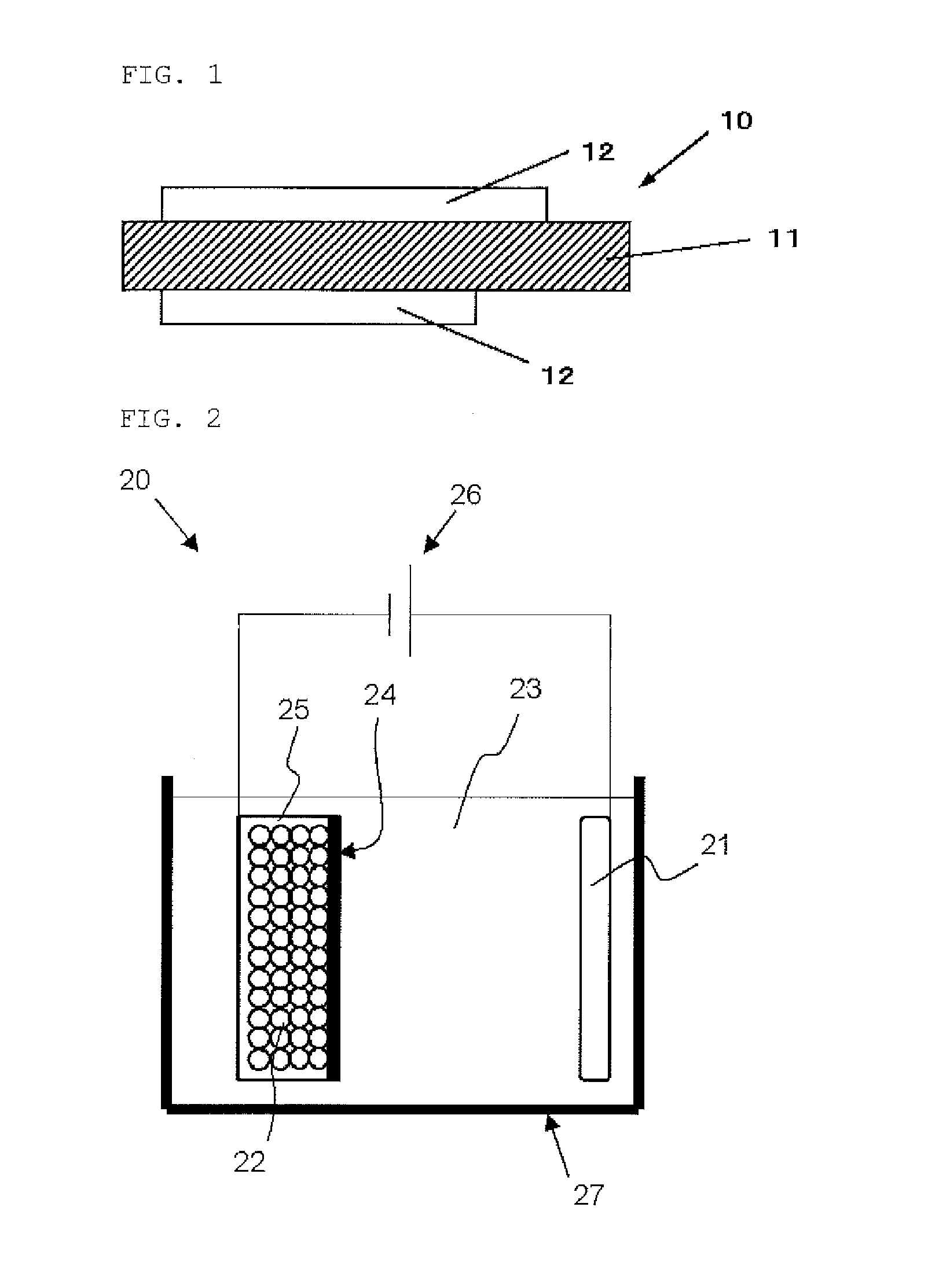Negative electrode material for non-aqueous electrolyte secondary battery, negative electrode for non-aqueous electrolyte secondary battery and method of producing the same, and non-aqueous electrolyte secondary battery
a secondary battery and negative electrode technology, applied in the direction of cell components, final product manufacturing, sustainable manufacturing/processing, etc., can solve the problems of electrolyte consumption, achieve excellent resistance to organic solvents and water solvents, reduce irreversible capacity, excellent capacity retention rate and initial efficiency
- Summary
- Abstract
- Description
- Claims
- Application Information
AI Technical Summary
Benefits of technology
Problems solved by technology
Method used
Image
Examples
example 1-1
[0173]The laminate film secondary battery 30 shown in FIG. 3 was produced by the following procedure.
[0174]The procedure began with the production of a positive electrode. Positive electrode active materials of 95 mass parts of LiCoO2, a lithium cobalt complex oxide, 2.5 mass parts of a positive electrode conductive additive, and 2.5 mass parts of a positive electrode binder (polyvinylidene fluoride, PVDF) were mixed to produce a positive-electrode mixture. The positive-electrode mixture was dispersed in an organic solvent (N-methyl-2-pyrrolidone, NMP) to form paste slurry. The slurry was applied to both surfaces of a positive electrode current collector with a coating apparatus having a die head and dried with a drying apparatus of hot-air type. The positive electrode current collector had a thickness of 15 μm. The resultant was finally compressed with a roll press.
[0175]Next, a negative electrode was produced. For the production of a negative electrode active material, a mixed raw...
examples 1-2 to 1-5
and Comparative Examples 1-1 and 1-2
[0178]A secondary battery was produced as in example 1-1 except that oxygen amount in a bulk of the silicon compound was adjusted. Consequently, the x-value of the silicon compound expressed by SiOx varied in the range of 0.3 to 1.8. The amount of accumulated oxygen was adjusted by changing the temperature and the ratio of raw materials to be vaporized.
[0179]The silicon compounds in examples 1-1 to 1-5 and comparative examples 1-1 and 1-2 had the following physical properties: the silicon compound had a median diameter D50 of 5 μm; the half width (2θ) of the diffraction peak attributable to a (111) crystal face and obtainable by X-ray diffraction was 1.22°; the crystallite size attributable to the (111) crystal face was 7.21 nm; the silicon compound contained LiF, Li2CO3, and Li2O on its surface; the active material contained Li4SiO4, Li6Si2O7, and Li2SiO3 in its interior. Moreover, the carbon content was 5.0 mass %. The content ratio of natural g...
examples 2-1 to 2-15
[0187]A secondary battery was produced as in example 1-3 except that the amount and the peak intensity ratio I1330 / I1580 in Raman spectrometry of the carbon material (the carbon coating) for coating the silicon compound and the carbon additive (the carbon-based material) to be added in the inventive negative electrode were adjusted, as well as the kind and the median size of the carbon additive were changed. Table 2 shows values such as the peak intensity ratio in Raman spectrometry of the carbon coating and the carbon-based material (the negative electrode conductive additive). The peak intensity ratio of the carbon coating was adjusted by changing the temperature and the pressure in the furnace in the thermal CVD. The peak intensity ratio of the carbon additive was adjusted by changing the carbon additive species among acetylene black, flake graphite, and grassy carbon.
TABLE 2Binder: SBR:CMC, Half width θ = 1.22, Si(111) crystallite: 7.21 nm, SiOx (x = 0.9), FEC:EC:DMC(1:2:7vol %)...
PUM
| Property | Measurement | Unit |
|---|---|---|
| crystallite size | aaaaa | aaaaa |
| 2θ | aaaaa | aaaaa |
| median size | aaaaa | aaaaa |
Abstract
Description
Claims
Application Information
 Login to View More
Login to View More - R&D
- Intellectual Property
- Life Sciences
- Materials
- Tech Scout
- Unparalleled Data Quality
- Higher Quality Content
- 60% Fewer Hallucinations
Browse by: Latest US Patents, China's latest patents, Technical Efficacy Thesaurus, Application Domain, Technology Topic, Popular Technical Reports.
© 2025 PatSnap. All rights reserved.Legal|Privacy policy|Modern Slavery Act Transparency Statement|Sitemap|About US| Contact US: help@patsnap.com


